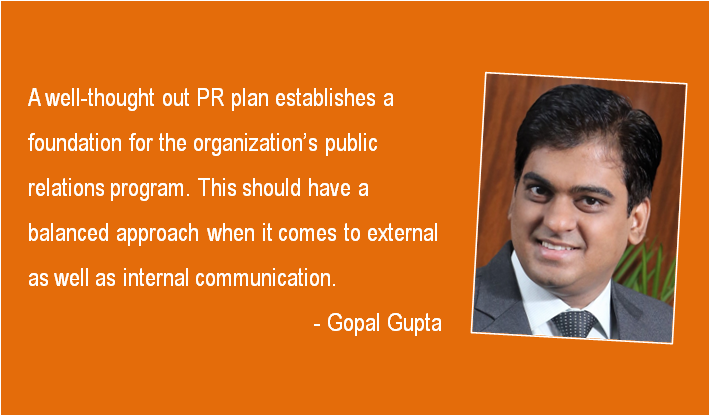Most of the PR professionals in developing countries like India go wrong at times in formulating the communication strategy for their Brands. Their strategies are largely inclined towards focusing majorly on wide media visibility and periodically pushing their brands and spokespersons to relevant media. Communication professionals across sectors have an ably focused approach towards implementing this plan, and some even manage to place their brands in the leading media spaces. But is this the right communication approach, always?
The development of any sound PR plan is a vital step towards improving your brand reputation and communicating relevant key messages to the prospective media and other target audiences. However, the recent communication trends created by most of the leading communication custodians show that ‘Brand Stability’ is as important an objective as ‘Brand Visibility’. Without a focused PR plan on Internal Communication Process/ Crisis Management Module/ Monitoring & Measurement Tools, brands often find that their efforts devolve into a string of random, disconnected tactics, rather than a coherent strategy that delivers optimal outcomes to audiences and the company itself in the long run.
A well-thought PR plan establishes a foundation for the organization’s public relations program. This should have a balanced approach when it comes to external as well as internal communication. While focusing on media visibility is an important tool which cannot be compromised in today’s media driven era, a well organised communication plan would not miss to capture effective internal communication plan, a well-defined cohesive crisis module and robust monitoring & measurement tools. These tools would not only help the relevant teams to mitigate any crisis situation with an astute matured approach, but help to track and monitoring them effectively with proper team coordination.
Focus on Crisis Management: There is a huge scope for the PR professionals & Corporate Communications department to evaluate and formulate an effective crisis management protocol. A crisis mismanaged can cause extreme damage to corporate reputation or even threaten the very survival of the company. Companies and businesses that do not have a crisis management plan in place are exposing themselves to an unnecessary risk, a liability fewcorporations can ill afford in an age of instant communications.
Thus, simply put Crisis Management Planning is the very brick and mortar for any viable business plan.A dedicated crisis modulewould help to pre-empt most of the crisis situations which shall help the business team to equip with the protocols and tools todeal with them – especially from a media standpoint. As after, it is the Media that can make or mar corporate reputation in today’s dynamically changing world. The Corporate Reputation is immensely critical if one wants to conduct a global business practice.
Proper formulated plan on these aspects would help the communication managers and the business / project teamsto deal with probable crisis through crisis management and crisis recovery techniques with situation oriented tools like, Holding Statements and detailed FAQs in multiple situations – helping them cope that much better!
After all when bad things happen to good companies the ability to deal with the crisis, is what separates truly professional world class corporate giants from therest.
Internal communication: A lot have been written and spoken about the relevance and importance on internal communication and its growing expectance and sophistication, embracing the latest technologies, publishing trends and thinking around face to face communication.
Internal communication within a corporate organization is important for its cohesive functioning and ensuring transparency across multiple departments. Lack of coordination and internal information deficit can be a major source of internal friction and embarrassment for an organization.
Effective Internal Communication strategy would help the communication professionals and employees be aligned on various aspects. Having effective internal communication processes and channels in place is the only way to ensure seamless functioning of different departments towards common shared goals.
Monitoring & Measurement: Monitoring and measurement have always been a hectic job and not many take them seriously. PR professionals should always have robust monitoring & measurement tool that adapts to changing conditions and constantly allows for improvement. Monitoring and measurement not only equips your organization with the information you need to intelligently modify campaigns and tactics for increased impact but also keep professionals & business teams updated about the upcoming crisis.
The views expressed here are that of the author and do not necessarily reflect that of Reputation Today.







Be the first to comment on "PR strategy – the right and the wrong"